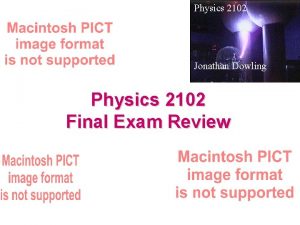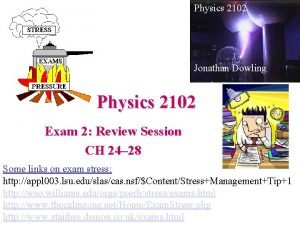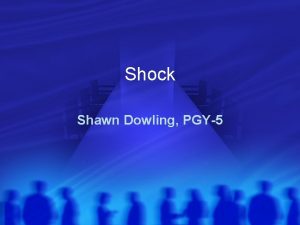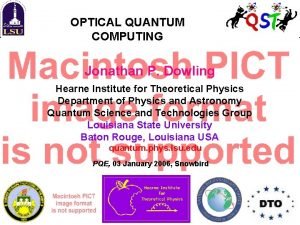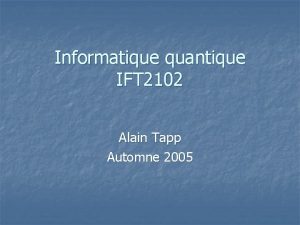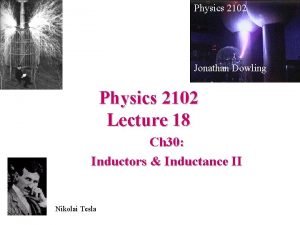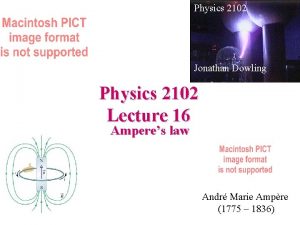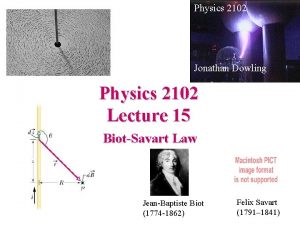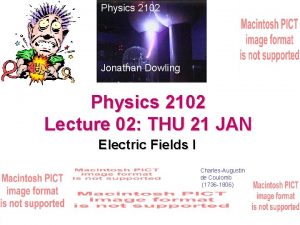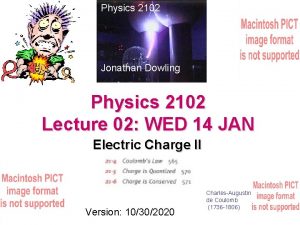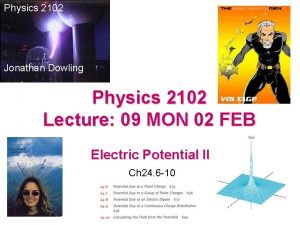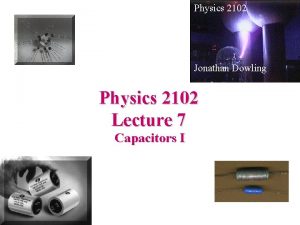Physics 2102 Jonathan Dowling Physics 2102 Lecture 6













- Slides: 13

Physics 2102 Jonathan Dowling Physics 2102 Lecture 6 Electric Potential II

Example Positive and negative charges of equal magnitude Q are held in a circle of radius R. 1. What is the electric potential at the center of each circle? • VA = • VB = • VC = 2. Draw an arrow representing the approximate direction of the electric field at the center of each circle. 3. Which system has the highest electric potential energy? UB –Q +Q A B C

Electric Potential of a Dipole (on axis) What is V at a point at an axial distance r away from the midpoint of a dipole (on side of positive charge)? a -Q +Q r Far away, when r >> a: V

Electric Potential on Perpendicular Bisector of Dipole You bring a charge of Qo = – 3 C from infinity to a point P on the perpendicular bisector of a dipole as shown. Is the work that you do: a) Positive? b) Negative? c) Zero? U= Qo. V=Qo(–Q/d+Q/d)=0 a -Q +Q d P -3 C

Continuous Charge Distributions • Divide the charge distribution into differential elements • Write down an expression for potential from a typical element — treat as point charge • Integrate! • Simple example: circular rod of radius r, total charge Q; find V at center. r dq

Potential of Continuous Charge Distribution: Example • Uniformly charged rod • Total charge Q • Length L • What is V at position P shown? x P dx L a

Electric Field & Potential: A Simple Relationship! Notice the following: • Point charge: – E = k. Q/r 2 – V = k. Q/r Focus only on a simple case: electric field that points along +x axis but whose magnitude varies with x. • Dipole (far away): – E ~ kp/r 3 – V ~ kp/r 2 • E is given by a DERIVATIVE of V! • Of course! Note: • MINUS sign! • Units for E -VOLTS/METER (V/m)

Electric Field & Potential: Example • Hollow metal sphere of radius R has a charge +q • Which of the following is the electric potential V as a function of distance r from center of sphere? V +q V (a) r=R V r r=R (c) r=R (b) r r

Electric Field & Potential: Example +q E V Outside the sphere: • Replace by point charge! Inside the sphere: • E =0 (Gauss’ Law) • E = –d. V/dr = 0 IFF V=constant

Equipotentials and Conductors • Conducting surfaces are EQUIPOTENTIALs • At surface of conductor, E is normal to surface • Hence, no work needed to move a charge from one point on a conductor surface to another • Equipotentials are normal to E, so they follow the shape of the conductor near the surface.

Conductors change the field around them! An uncharged conductor: A uniform electric field: An uncharged conductor in the initially uniform electric field:

“Sharp”conductors • Charge density is higher at conductor surfaces that have small radius of curvature • E = s/e 0 for a conductor, hence STRONGER electric fields at sharply curved surfaces! • Used for attracting or getting rid of charge: – lightning rods – Van de Graaf -- metal brush transfers charge from rubber belt – Mars pathfinder mission -- tungsten points used to get rid of accumulated charge on rover (electric breakdown on Mars occurs at ~100 V/m) (NASA)

Summary: • Electric potential: work needed to bring +1 C from infinity; units = V • Electric potential uniquely defined for every point in space -- independent of path! • Electric potential is a scalar -- add contributions from individual point charges • We calculated the electric potential produced by a single charge: V=kq/r, and by continuous charge distributions : V= kdq/r • Electric field and electric potential: E= -d. V/dx • Electric potential energy: work used to build the system, charge by charge. Use W=q. V for each charge. • Conductors: the charges move to make their surface equipotentials. • Charge density and electric field are higher on sharp points of conductors.
 Jonathan dowling
Jonathan dowling Jonathan dowling
Jonathan dowling International human resource management dowling 6th edition
International human resource management dowling 6th edition Shock mnemonic
Shock mnemonic Dowling optical
Dowling optical Dowling roundabout
Dowling roundabout 01:640:244 lecture notes - lecture 15: plat, idah, farad
01:640:244 lecture notes - lecture 15: plat, idah, farad Sos.texas.gov form 2102
Sos.texas.gov form 2102 Ift-2102
Ift-2102 Nutrition 2102
Nutrition 2102 Nutrition 2102
Nutrition 2102 Nutrition 3102
Nutrition 3102 Physics 101 lecture notes pdf
Physics 101 lecture notes pdf Physics 101 lecture 1
Physics 101 lecture 1
